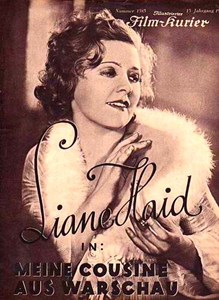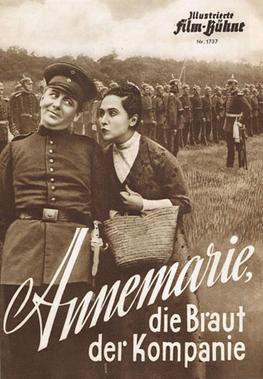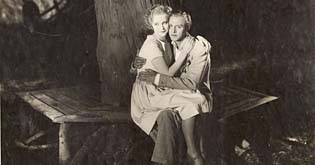Related Research Articles
UFA GmbH, shortened to UFA, is a film and television production company that unites all production activities of the media conglomerate Bertelsmann in Germany. The original UFA was established as Universum-Film Aktiengesellschaft on December 18, 1917, as a direct response to foreign competition in film and propaganda. UFA was founded by a consortium headed by Emil Georg von Stauß, a former Deutsche Bank board member. In March 1927, Alfred Hugenberg, an influential German media entrepreneur and later Minister of the Economy and Minister of Agriculture and Nutrition in Adolf Hitler's cabinet, purchased UFA and transferred ownership of it to the Nazi Party in 1933.

German expressionist cinema was a part of several related creative movements in Germany in the early 20th century that reached a peak in Berlin during the 1920s. These developments were part of a larger Expressionist movement in north and central European culture in fields such as architecture, dance, painting, sculpture and cinema.

SV Babelsberg 03 is a German association football club based in Potsdam-Babelsberg, on the outskirts of Berlin. The team was founded as Sport-Club Jugendkraft 1903 and again as SG Karl-Marx Babelsberg in 1948 as successor to the pre-war side SpVgg Potsdam 03.

Babelsberg Film Studio, located in Potsdam-Babelsberg outside Berlin, Germany, is the second oldest large-scale film studio in the world only preceded by the Danish Nordisk Film, producing films since 1912. With a total area of about 460,000 square metres (5,000,000 sq ft) and a studio area of about 25,000 square metres (270,000 sq ft) it is Europe's largest film studio.

The Student of Prague is a 1913 German silent horror film. It is loosely based on "William Wilson", a short story by Edgar Allan Poe, the poem The December Night by Alfred de Musset, and Faust. The film was remade in 1926, under the same title The Student of Prague. Another remake was produced in 1935. The film stars Paul Wegener in his film debut. It is generally deemed to be the first German art film. Composer Josef Weiss wrote a piano score to accompany the film. It was the first film score written for a German language film in the history of cinema.

The Night of Queen Isabeau is a 1920 German silent historical drama film directed by Robert Wiene and starring Fern Andra, Fritz Kortner, Hans Heinrich von Twardowski and Elsa Wagner. The film depicts the marriage between the mad Charles VI of France and his wife Queen Isabeau. It was shot at the Babelsberg Studios in Berlin. The film is now considered a lost film, but contemporary reviews praised Wiene's direction. The story revolves around insanity, a common theme in his films.
The Adventure of Mr. Philip Collins is a 1925 German silent comedy film directed by Johannes Guter and starring Georg Alexander, Ossi Oswalda and Elisabeth Pinajeff. It was one of two comedy films with which Guter followed up his more melancholy The Tower of Silence. It was shot at UFA's Babelsberg Studios. The film's art direction was by Rudi Feld. It premiered at the Gloria-Palast in Berlin..

My Cousin from Warsaw is a 1931 German comedy film directed by Carl Boese and starring Liane Haid, Tala Birell, and Fritz Schulz. It was shot at the Babelsberg Studios in Berlin. The film's art director was Julius von Borsody. A separate French language version Ma cousine de Varsovie was also made, directed by Carmine Gallone. The film was based upon the play by Louis Verneuil.
The Blood of the Ancestors is a 1920 German silent film directed by Karl Gerhardt and starring Robert Scholz, Harald Paulsen, and Lil Dagover. It was shot at the Babelsberg Studios of Decla-Bioscop in Berlin. The film's art direction was by Hermann Warm.
The Eyes of the Mask is a 1920 German silent film directed by Karl Gerhardt and starring Lil Dagover.
The Tophar Mummy is a 1920 German silent film directed by Johannes Guter.

Annemarie, the Bride of the Company is a 1932 German comedy film directed by Carl Boese and starring Lucie Englisch, Paul Heidemann and Albert Paulig. It was shot at the Babelsberg Studios in Berlin. The film's sets were designed by the art director Willi Herrmann.

At Ruedesheimer Castle There Is a Lime Tree is a 1928 German silent film directed by Johannes Guter and starring Werner Fuetterer, Marija Leiko and Alvin Neuss. It was made by the German subsidiary of the American Fox Film company. It takes its title from a popular German song of the same name.

His Toughest Case is a 1926 German silent crime film directed by Fritz Wendhausen and starring Alexander Murski, Christa Tordy and Olga Chekhova. It was shot at the Babelsberg Studios in Berlin. The film's art direction was by Hans Jacoby. It premiered at the Ufa-Palast am Zoo.

Love Must Be Understood is a 1933 German musical comedy film directed by Hans Steinhoff and starring Rosy Barsony, Georg Alexander, and Wolf Albach-Retty. It was shot at the Babelsberg Studios in Berlin. The film's sets were designed by the art director Benno von Arent.

The Battle of Bademunde is a 1931 German comedy film directed by Philipp Lothar Mayring and starring Max Adalbert, Claire Rommer and Paul Wagner. It was one of a number of military comedies made during the late Weimar era. It was shot at the Babelsberg Studios in Berlin. The film's sets were designed by the art director Artur Günther. It was produced and distributed by UFA, Germanys largest film company of the era.

The White Roses of Ravensberg is a 1919 German silent drama film directed by and starring Nils Olaf Chrisander. It is based on the 1896 novel by Eufemia von Adlersfeld-Ballestrem which was later adapted into a 1929 film of the same title.
The Thirteen of Steel is a 1921 German silent crime film directed by Johannes Guter and starring Carl de Vogt, Georg H. Schnell and Claire Lotto. It was produced by Erich Pommer for Decla-Bioscop before the company merged with UFA. It was shot at the Babelsberg Studios in Berlin. The film's sets were designed by the art director Franz Seemann.

A Wife for Three Days is a 1944 German romantic drama film directed by Fritz Kirchhoff and starring Hannelore Schroth, Carl Raddatz and Ursula Herking. It was shot at the Babelsberg Studios in Potsdam and on location around Berlin and its vicinity including the River Havel and Wannsee. Filming also took place in Salzburg and Mondsee in Austria. The film's sets were designed by the art director Erich Kettelhut.

Donogoo is a 1936 French-German comedy film directed by Henri Chomette and Reinhold Schünzel and starring Renée Saint-Cyr, Raymond Rouleau and Marcel Simon. It was produced and distributed by the French subsidiary of Germany's UFA. Shooting took place at the Babelsberg Studios in Berlin. The film's sets were designed by the art directors Otto Hunte and Willy Schiller.